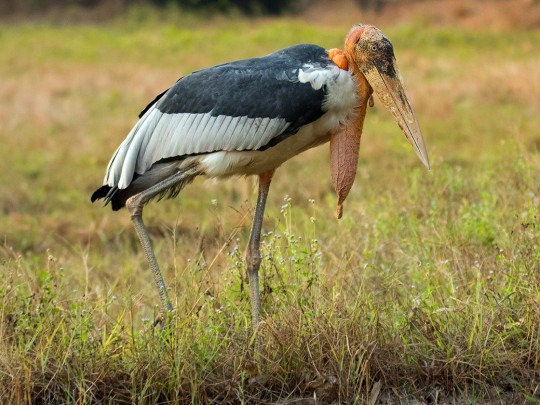#Leptoptilos dubius
Explore tagged Tumblr posts
Text

Rajamanohar Stephen
Greater Adjutant Stork
Wikipedia
The greater adjutant (Leptoptilos dubius) is a member of the stork family, Ciconiidae. Its genus includes the lesser adjutant of Asia and the marabou stork of Africa. Once found widely across southern Asia and mainland southeast Asia, the greater adjutant is now restricted to a much smaller range with only three breeding populations; two in India, with the largest colony in Assam, a smaller one around Bhagalpur; and another breeding population in Cambodia. They disperse widely after the breeding season. This large stork has a massive wedge-shaped bill, a bare head and a distinctive neck pouch. During the day, it soars in thermals along with vultures with whom it shares the habit of scavenging. They feed mainly on carrion and offal; however, they are opportunistic and will sometimes prey on vertebrates. The English name is derived from their stiff "military" gait when walking on the ground. Large numbers once lived in Asia, but they have declined (possibly due to improved sanitation) to the point of endangerment. The total population in 2008 was estimated at around a thousand individuals.
21 notes
·
View notes
Note
Can I get some good vibes please? My grandmother is in the hospital and they haven’t figured anything out yet. I’m really scared.
Not sure if we're doing mood booster, good news, or prayers so I'm gonna go the blunderbuss method and do all 3.
First from Double Simba poor baby.
And here's a quoaka and their Joey playing peekaboo

That's all good news there

I will absolutely pray for you and your grandmother as well, and I am asking my followers if they wouldn't mind joining in at some point whenever the mood strikes to send a prayer or a good thought both of your's ways.
Rest of your family as well
16 notes
·
View notes
Text
The Greater Adjutant Stork: A Portrait of a Majestic Bird
In the vast and intricate tapestry of the natural world, certain creatures stand out not only for their physical grandeur but also for their ecological significance. One such magnificent being is the Greater Adjutant Stork (*Leptoptilos dubius*), a species that epitomizes both resilience and elegance in the avian realm. From its distinctive appearance to its vital role in its ecosystem, the…

View On WordPress
0 notes
Text
An Army of 10,000 Women Saved India’s Rarest Stork – While Giving Each Other a New identity
👏
1 note
·
View note
Photo

Greater Adjutant
124 notes
·
View notes
Photo

A greater adjutant stork gulps a snake in a wetland in Pobitora wildlife sanctuary on the outskirts in Gauhati, India
Photograph: Anupam Nath/AP
(via The week in wildlife - in pictures | Environment | The Guardian)
#Greater Adjutant#Leptoptilos dubius#Leptoptilos#Ciconiidae#Ciconiiformes#Aves#birds#stork#predation#India
41 notes
·
View notes
Photo

One animal’s trash is another animal’s treasure—just ask the Greater Adjutant (Leptoptilos dubius).🗑 This South Asian resident, which is known for eating large carrion, is often seen hanging out around landfills, scavenging whatever treats it can find. When it’s not rummaging through garbage, it might be spotted in wetland habitats, going after tasty fish and crustaceans. This large bird has a wingspan that can reach more than 8 feet (2.5 meters), and it can grow to nearly 5 feet (1.5 meters) tall. Photo: Francesco Veronesi, CC BY-SA 2.0, flickr #AnimalFacts #birds #GreaterAdjutant #trash #ornithology https://www.instagram.com/p/CbgdMeCrEkK/?utm_medium=tumblr
504 notes
·
View notes
Text
Animal of the Day!
Greater Adjutant (Leptoptilos dubius)

(Photo by Ayuwat Jearwattanakanok)
Conservation Status- Endangered
Habitat- Asia
Size (Weight/Length)- 8 kg; 120 cm; 250 cm wingspan
Diet- Fish; Frogs; Insects; Reptiles; Crustaceans; Carrion
Cool Facts- If you want to be afraid of a bird, the greater adjutant looks like a serial killer from an 80’s movie. Living in small flocks, greater adjutant patrol marshlands in search of food. While greater adjutants prefer carrion, they will hunt anything that is small enough to fit in their beaks. During the breeding seasons, these flocks combine with other species of large water birds to nest. Trees are scarce and so nest space is fought over and defended viciously.
Rating- 12/10 (Vulture: the stork.)
#Animal of the day#Animals#Birds#Storks#Thursday#June 23#Greater adjutant#biology#science#conservation#the more you know
42 notes
·
View notes
Photo

Greater adjutant (Leptoptilos dubius)
12 notes
·
View notes
Photo

Leptoptilos dubius by Roger Wasley.
0 notes
Text
ត្រដក់ធំ
សត្វត្រដក់ធំ មានឈ្មោះជាភាសាអង់គ្លេស Greater Adjutant និងឈ្មោះវិទ្យាសាស្ត្រ Leptoptilos dubius ។ ត្រដក់ធំ ជាប្រភេទសត្វស្លាបជិតផុតពូជលើពិភពលោក ដែលមាននៅក្នុងបញ្ជីក្រហមរបស់ IUCN ហើយសត្វប្រភេទនេះ មានវត្តមាននៅប្រទេសបង់ក្លាដែស នេប៉ាល់ ភូមា ថៃ វៀតណាម និងមានកន្លែងបន្តពូជតែនៅប្រទេសឥណ្ឌា និងកម្ពុជាប៉ុណ្ណោះ ។ ចំនួនសរុប សត្វប្រភេទនេះមានក្នុងពិភពលោក…

View On WordPress
0 notes
Text
Day 132
Thursday 30 July
I read a couple of shocking articles this morning that made me too upset to be sad.
In the slums of north-east India, the Greater Adjutant stork mixes with humans to forage in the rubbish tips for food. They also roost there at night.

The Greater Adjutant stork (Leptoptilos dubius). Dignity and habitat wiped away by human ambition.
The storks’ wetland habitat is…
View On WordPress
0 notes
Photo

#RamsarWetland Cambodia currently has 5 sites designated as Wetlands of International Importance (Ramsar Sites), with a surface area of 85,235 hectares. 4- Prek Toal Ramsar Site Site number: 2,245 Country: Cambodia Administrative region: Battambang province Area: 21,342 ha Designation dates: 02-10-2015 The Prek Toal Ramsar Site includes some of the most pristine floodplains in the Tonle Sap Biosphere Reserve in Cambodia. During the dry seasons, the Site is dry and covered mostly by freshwater swamp forests, but it floods annually, with the water depth reaching up to eight metres. Prek Toal is at the north-west upstream end of Tonle Sap Lake and the rise and fall of the lake’s waters play a vital role in maintaining its biological wealth. The forests trap large quantities of sediment, and the nutrients deposited stimulate the growth of plants and fish which support the high numbers of waterbirds and other wildlife at the Site. Prek Toal includes a range of habitats for a great diversity of globally threatened species such as the critically endangered river terrapin (Batagur baska), Siamese crocodile (Crocodylus siamensis), giant barb (Catlocarpio siamensis), and Mekong giant catfish (Pangasianodon gigas). The high concentration and diversity of nesting waterbirds (with over 20,000 counted regularly since 2001), including many globally threatened species such as the endangered greater adjutant (Leptoptilos dubius) and masked finfoot (Heliopais personatus), make the area unique in the biogeographic region. The local communities live in floating houses and depend on fishing and aquaculture for their livelihoods. https://www.instagram.com/p/B3RZP0slyuf/?igshid=1hv43v66yuuxl
0 notes
Photo

One animal’s trash is another animal’s treasure—just ask the Greater Adjutant (Leptoptilos dubius). This South Asian resident, which is known for eating large carrion, is often seen hanging out around landfills, scavenging whatever treats it can find. When it’s not rummaging through garbage, it might be spotted in wetland habitats, going after tasty fish and crustaceans. This large bird has a wingspan that can reach more than 8 feet (2.5 meters), and it can grow to nearly 5 feet (1.5 meters) tall. Photo: Free pictures for conservation, CC BY-NC-SA 2.0, flickr https://www.instagram.com/p/CMwz5K4ALDV/?igshid=1cv2e1qc07noo
271 notes
·
View notes
